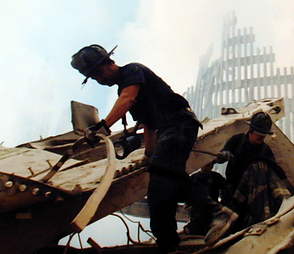

Memories of September 11, 2001:
Using Digital Tools to Create Opportunities for Sharing, Empathy, and Discussion
Overview
This lesson encourages students to draw upon digital literacy to research and to discuss memories of September 11, 2001. The series of four coordinated terrorist attacks by the Islamic terrorist group al-Qaeda on the U.S. on Tuesday, September 11, 2001 continue to deeply affect U.S. identity and politics. Through an online academic forum, students compare observations of memories of September 11, 2001 and demonstrate empathy in a digital age.
Rationale
For the first time, since September 11, 2011, the 9th grade students who arrive in our high school classrooms in August or September have little to no first hand memory of the events that took place on U.S. soil that has come to be known as “9/11.” On September 11, 2001, the United States was attacked in four separate incidents involving jet airliners that had been hijacked by members of a terrorist organization known as Al-Qaeda. In New York City, the World Trade Center was hit by two separate planes. A third plane was set to crash into the White House, when passengers rushed the cockpit, took over the controls, and crashed the plane into a field in Pennsylvania; all lives on board were sacrificed. The fourth airliner crashed into the Pentagon.
“While historians and history students can use traditional documents to reconstruct the past, everyday people fall through the cracks in the written record.”
--- Kathryn Walbert, Southern Oral History Program

In all, thousands of lives were lost, and airline travel, privacy, and national identity as people in the United States knew it changed unalterably. Importantly, living in a “Post 9/11 Era” has resulted in "contested meanings" (O'Brien, 2011) around what it means to be a U.S. patriot.
The overarching purpose of this unit of instruction is to help high school students to understand the importance of sharing memories as a form of oral history, especially about an important event in U.S. history like September 11, 2001. Though current high school history books might not yet have detailed, first-hand information about September 11, students who have the ability to participate in an asynchronous conversation with someone who actually experienced the September 11 event may gain empathy in a way that words on a page might not fully be able to provide.
Engaging in a digital social discussion forum can allow students asynchronous access to individuals who experienced the events of September 11 personally and emotionally. Such access can confer the ability for students to engage in dialogue so that they learn about the events of the day in deeper and meaningful ways. The word, dialogue is an important word to explain to students. The goal here is not for students to come to consensus on specific points or events around September 11, rather we want to students to hear diverse perspectives on this topic so that they can continue to have dialogues--rather than discussions--on their own in the future.
Moreover, it gives students an opportunity to learn about another person who is not necessarily part of their immediate community in order to expand their social horizons in a safe manner. As a whole, this unit seeks to re-conceptualize how teenagers learn from and communicate with “everyday people” about a day in history that many will never forget.
Encouraging students to participate in civic engagement through discussion in digital forum is a skill that many teenagers may not have yet developed. Although, according to Gao, et al, asynchronous discussion environments support important learning objectives, teachers often design threaded forums, which “do not foster productive online discussions.” This unit on “Memories of September 11, 2001” helps student discussions to emerge organically from teens’ authentic areas of interest, which can generate deeper civic engagement, shared purposes, transparency, and increased participatory culture.
Using Flipgrid, an asynchronous digital discussion tool, students engage with people who aren’t able to come into their classroom for a lecture but who can provide first-hand knowledge and experience on the topic of September 11. Flipgrid extends the classroom far beyond the school day. Students who may feel reluctant to participate in a discussion within the four walls of their classroom can plan what they have to say without feeling pressure from their peers (Repman, et al., 2005).
A Note on Supporting Students’ Socioemotional Competencies
Students who have the opportunity to engage in soft skills such as showing empathy as well as establishing and maintaining relationships with others are often more successful in both their academic and personal lives. According to Hamedani and Hammond (2015, p. 1):
“social emotional learning school environments and practices hold the potential to better equip students with critical psychological resources and social emotional supports that they need to feel like school is important, that they belong there, and that they can be successful.”
By providing students with the opportunity to connect with others through dialogue, not only do we help students to break down walls that can interfere with the ability to engage in rich conversations, but we also provide them with opportunities to practice speaking and listening with others in a safe, mediated space.
Such contexts require scaffolded, advanced planning that include opportunities for students to gain motivation, discussion guidelines with clear expectations, a strong sense of community, and attention to issues of social equity.







